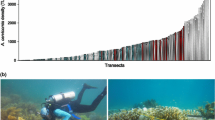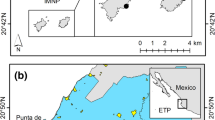Abstract
Stony corals are the foundation of coral reef ecosystems and form associations with other reef species. Many of these associations may be ecologically important and play a role in maintaining the health and diversity of reef systems, rendering it critical to understand the influence of symbiotic organisms in mediating responses to perturbation. This study demonstrates the importance of an association with trapeziid crabs in reducing adverse effects of sediments deposited on corals. In a field experiment, mortality rates of two species of branching corals were significantly lowered by the presence of crabs. All outplanted corals with crabs survived whereas 45–80% of corals without crabs died within a month. For surviving corals that lacked crabs, growth was slower and tissue bleaching and sediment load were higher. Laboratory experiments revealed that corals with crabs shed substantially more of the sediments deposited on coral surfaces, but also that crabs were most effective at removing grain sizes that were most damaging to coral tissues. The mechanism underlying this symbiotic relationship has not been recognized previously, and its role in maintaining coral health is likely to become even more critical as reefs worldwide experience increasing sedimentation.


Similar content being viewed by others
References
Abele LG, Patton WK (1976) The size of coral heads and the community biology of associated decapod crustaceans. J Biogeogr 3:35–47
Bellwood DR, Hughes TP, Folke C, Nystrom M (2004) Confronting the coral reef crisis. Nature 429:827–833
Coen LD (1988) Herbivory by crabs and the control of algal epibionts on Caribbean host corals. Oecologia 75:198–203
Davies PS (1989) Short-term growth measurements of corals using an accurate buoyant weighing technique. Mar Biol 101:389–396
Fabricius KE (2005) Effects of terrestrial runoff on the ecology of corals and coral reefs: review and synthesis. Mar Pollut Bull 50:125–146
Glynn PW (1976) Some physical and biological determinants of coral community structure in the Eastern Pacific. Ecol Monogr 46:431–456
Glynn PW (1980) Defense by symbiotic crustacea of host corals elicited by chemical cues from predator. Oecologia 47:287–290
Goldshmid R, Holzman R, Weihs D, Genin A (2004) Aeration of corals by sleep swimming fish. Limnol Oceanogr 49:1832–1839
Holbrook SJ, Schmitt RJ (2005) Growth, reproduction and survival of a tropical sea anemone (Actinaria): benefits of hosting anemonefish. Coral Reefs 24:67–73
Huber ME (1987) Aggressive behavior of Trapezia intermedia Miers and Trapezia digitalis Latreille (Brachyura: Xanthidae). Journal of Crustacean Biology 7:238–248
Huber ME, Coles SL (1986) Resource utilization and competition among the five Hawaiian species of Trapezia (Crustacea, Brachyura). Mar Ecol Prog Ser 30:21–31
Hughes TP (1994) Catastrophes, phase-shifts, and large-scale degradation of a Caribbean coral-reef. Science 265:1547–1551
Hughes TP, Connell JH (1987) Population dynamics based on size or age? A reef coral analysis. Am Nat 129:818–829
Hughes TP, Jackson JBC (1980) Do corals lie about their age?—some demographic consequences of partial mortality, fission, and fusion. Science 209:713–715
Kleypas JA, Buddemeier RW, Archer D, Gattuso JP, Langdon C, Opdyke BN (1999) Geochemical consequences of increased atmospheric carbon dioxide on coral reefs. Science 284:118–120
Knowlton N (2001) The future of coral reefs. Proc Natl Acad Sci USA 98:5419–5425
Lasker HR (1980) Sediment rejection by reef corals—the roles of behavior and morphology in Montastrea cavernosa (Linnaeus). J Exp Mar Biol Ecol 47:77–87
Lassig BR (1977). Communication and coexistence in a coral community. Mar Biol 42:85–92
Liberman T, Genin A, Loya Y (1995) Effects on growth and reproduction of the coral Stylophora pistillata by the mutualistic damselfish Dascyllus marginatus. Mar Biol 121:741–746
Meyer JL, Schultz ET (1985) Migrating haemulid fishes as a source of nutrients and organic matter on coral reefs. Limnol Oceanogr 30:146–156
Mills MM, Sebens KP (2004) Ingestion and assimilation of nitrogen from benthic sediments by three species of coral. Mar Biol 145:1097–1106
Mokady O, Loya Y, Lazar B (1998) Ammonium contribution from boring bivalves to their coral host—a mutualistic symbiosis? Mar Ecol Prog Ser 169:295–301
Patton WK (1994) Distribution and ecology of animals associated with branching corals (Acropoa spp.) from the Great Barrier Reef, Australia. Bull Mar Sci 55:193–211
Pratchett MS (2001) Influence of coral symbionts on feeding preferences of crown-of-thorns starfish Acanthaster planci in the western Pacific. Mar Ecol Prog Ser 214:111–119
Pratchett MS, Vytopil, E, Parks P (2000) Coral crabs influence the feeding patterns of crown-of-thorns starfish. Coral Reefs 19:36
Rinkevich B, Wolodarshy Z, Loya Y (1991) Coral–crab association: a compact domain of a multilevel trophic system. Hydrobiologia 216/217:279–284
Schmitt RJ, Holbrook SJ (2003) Mutualism can mediate competition and promote coexistence. Ecol Lett 6:898–902
Spotte S (1996) Supply of regenerated nitrogen to sea anemones by their symbiotic shrimp. J Exp Mar Biol Ecol 198:27–36
Stachowicz JJ, Hay ME (1999) Mutualism and coral persistence: The role of herbivore resistance to algal chemical defence. Ecology 80:2085–2101
Stafford-Smith MG, Ormond RFG (1992) Sediment-rejection mechanisms of 42 species of Australian scleractinian corals. Aust J Mar Freshw Res 43:683–705
Stimson J (1990) Stimulation of fat-body production in the polyps of the coral Pocillopora damicornis by the presence of mutualistic crabs of the genus Trapezia. Mar Biol 106:211–218
Vannini M (1985) A shrimp that speaks crab–ese. Journal of Crustacean Biology 5:160–167
Vytopil E, Willis BL (2001) Epifaunal community structure in Acropora spp. (Scleractinia) on the Great Barrier Reef: implications of coral morphology and habitat complexity. Coral Reefs 20:281–288
Weber JN, Woodhead PMJ (1970) Ecological studies of coral predator Acanthaster planci in the South Pacific. Mar Biol 6:12–17
Wilby RL, Dalgleish HY, Foster IDL (1997) The impact of weather patterns on historic and contemporary catchment sediment yields. Earth Surf Process Landf 22:353–363
Zann LP (1994) The status of coral reefs in south western Pacific Islands. Mar Pollut Bull 29:52–61
Acknowledgments
We thank S. A. Gravem, S. Holloway and K. Seydel for outstanding assistance in the field. This manuscript was improved by the comments of J. Stachowicz and an anonymous reviewer. Thanks to C. McKeon and G. Paulay for species identification. We gratefully acknowledge the support of the National Science Foundation (OCE 99-10677; OCE 04-17412), the W.M. Keck Foundation and the Gordon and Betty Moore Foundation. This is a contribution of the Moorea Coral Reef (MCR) LTER Site and is Contribution No. 91 of the UC Berkeley Gump Research Station.
Author information
Authors and Affiliations
Corresponding author
Additional information
Communicated by Biology Editor H.R. Lasker
Rights and permissions
About this article
Cite this article
Stewart, H.L., Holbrook, S.J., Schmitt, R.J. et al. Symbiotic crabs maintain coral health by clearing sediments. Coral Reefs 25, 609–615 (2006). https://doi.org/10.1007/s00338-006-0132-7
Received:
Accepted:
Published:
Issue Date:
DOI: https://doi.org/10.1007/s00338-006-0132-7




